Seagrass as Climate-Smart Insulation for the Tropics: Key Insights from Numerical Simulations and Field Studies
Abstract
1. Introduction
2. Materials and Methods
2.1. Calculation of the Insulation Properties
- Variant 1: Façade insulation
- Variant 1.1: Façade insulation without vapour barrier
- Variant 1.2: Façade insulation without rear ventilation
- Variant 2: Wooden stud frame
2.2. Expert Interviews
3. Results
3.1. Simulation Results for Seagrass Insulation Assemblies
- Results Variant 1
- Results Variant 1.1
- Results Variant 1.2
- Results Variant 2
3.2. Results from the Expert Interviews
3.2.1. Special Features on the Response Rate
3.2.2. Experience and Key Figures of the Seagrass Industry
- Collection process
- Treatment process
- Quantity of material required
- Areas of application
- Botanical and Ecological Findings
- Beach Wrack
3.2.3. Challenges of the Use of Seagrass
- Time Expenditure
- Economic efficiency
- Ecological Liabilities from Seagrass Use
- Question of the Suitability of Seagrass on Tropical Islands
- Regulatory and Business Hurdles
- General Reasons for low Market Share and Attention
3.2.4. Opportunities Through Seagrass Insulation
- Seagrass Properties
- Ecological Advantages
- Ideas of Dissemination and Use
- Positive Influence in Tourism
4. Discussion
4.1. Recommended Structure
- Family Cymodoceaceae
- ○
- Cymodocea serrulata: One of the dominant species in Palk Bay and the Gulf of Mannar, it thrives in shallow, sandy substrates and is known for its high resilience to environmental stressors.
- ○
- Cymodocea rotundata: Frequently coexisting with C. serrulata, this species is important for stabilizing sediment and providing habitat for marine fauna.
- ○
- Halodule uninervis: A widespread species found in Chilika Lake, Gulf of Mannar, and the Andaman Islands, it plays a crucial role in nutrient cycling and primary production.
- ○
- Halodule pinifolia: Found in the Lakshadweep Islands and shallow coastal areas, this species is highly adapted to varying salinity levels.
- Family Hydrocharitaceae
- ○
- Halophila ovalis: One of the most widely distributed seagrasses in India, occurring in both intertidal and subtidal regions along the east and west coasts. It has high growth rates and colonization potential, making it a key species for seagrass restoration efforts.
- ○
- Halophila beccarii: A vulnerable species found in mangrove-associated ecosystems on both coasts, it thrives in low-salinity, muddy habitats and is highly sensitive to anthropogenic pressures.
- ○
- Enhalus acoroides: The largest seagrass species in India, primarily found in the Andaman and Nicobar Islands, it is important for providing habitat for dugongs and sea turtles.
4.2. Lack of Presence and Acceptance
4.3. Practical and Ecological Considerations for Seagrass Insulation Implementation
4.4. Possible Use of Seagrass Insulation
4.5. Seagrass Management and Sustainable Supply Chains as Ocean Conservation Opportunity
5. Conclusions and Outlook
- Improving public perception and awareness of seagrass as a valuable building material through educational campaigns, industry outreach, and integration into construction guidelines.
- Expanding the study scope to other tropical regions, conducting a systematic stakeholder consultation process, and refining the research methodology for higher significance and applicability.
- Investigating the physical performance of seagrass insulation by analysing its thermal conductivity, moisture regulation, fire resistance, and long-term durability in tropical climates. Developing a dynamic moisture protection model to assess insulation behaviour under varying climatic conditions.
- Assessing local seagrass availability by conducting ecological impact studies and collaborating with policymakers to determine sustainable harvesting guidelines.
Author Contributions
Funding
Institutional Review Board Statement
Informed Consent Statement
Data Availability Statement
Conflicts of Interest
Abbreviations
| B | Biology sector |
| DAD | External insulation of the roof |
| DI | Internal insulation of the ceiling or the roof |
| DZ | Inter-rafter insulation of the roof or the upper storey ceiling |
| EPS | Expanded polystyrene |
| GT | Gigatons |
| H | Tourism sector Seychelles |
| MT | Megatons |
| MDPI | Multidisciplinary Digital Publishing Institute |
| PU | Polyurethane |
| S | Seagrass insulation sector |
| SBS | Seychelles Bureau of Standards |
| SPA | Seychelles Planning Authority |
| U | Construction company sector |
| UNEP | United Nations Environment Programme |
| WAB | External insulation of the wall behind the cladding |
| WH | Insulation of double walls for core insulation |
| WI | Internal wall insulation |
| WTR | Insulation of partition walls |
| WZ | External insulation behind the sealing |
| XPS | Extruded polystyrene |
References
- Duarte, C.; Losada, I.; Hendriks, I.; Mazarrasa, I. The Role of Coastal Plant Communities for Climate Change Mitigation and Adaptation. Nat. Clim. Chang. 2013, 3, 961–968. [Google Scholar] [CrossRef]
- Palacios, M.; Costa, M.; Wartman, M.; Ebrahim, A. Seychelles’ Blue Carbon Roadmap. Available online: https://www.bluecarbonlab.org/wp-content/uploads/2022/09/SeychellesBlueCarbonRoadmap_Report_202209.pdf (accessed on 16 April 2022).
- United Nations Environment Programme. Out of the Blue: The Value of Seagrasses to the Environment and to People; United Nations Environment Programme: Nairobi, Kenya, 2020. [Google Scholar]
- United Nations Environment Programme. Global Status Report for Buildings and Construction. Towards a Zero-Emission, Efficient and Resilient Buildings and Construction Sector; United Nations Environment Programme: Nairobi, Kenya, 2021. [Google Scholar]
- Stelljes, N. Using Seagrass as Insulation Material. Balt. Stories Mag. 2021, 2, 16–17. [Google Scholar]
- Geevarghese, G.; Akhil, B.; Magesh, G. A comprehensive geospatial assessment of seagrass distribution in India. Ocean Coast. 2018, 159, 16–25. [Google Scholar] [CrossRef]
- Ramesh, C.; Mohanraju, R. Seagrass Ecosystems of Andaman and Nicobar Islands: Status and Future Perspective. Environ. Earth Sci. Res. J. 2020, 7, 169–174. [Google Scholar] [CrossRef]
- Mishra, A.; Apte, D. The current status of Halophila beccarii: An ecologically significant, yet vulnerable seagrass of India. Ocean Coast. Manag. 2021, 200, 105484. [Google Scholar] [CrossRef]
- Bindoff, N.; Cheung, W.; Kairo, J.; Arístegui, J. IPCC Special Report on the Ocean and Cryosphere in a Changing Climate; Intergovernmental Panel on Climate Change: Geneva, Switzerland, 2019. [Google Scholar]
- Short, F.; Carruthers, T.; Dennison, W. Global seagrass distribution and diversity: A bioregional model. J. Exp. 2007, 350, 3–20. [Google Scholar] [CrossRef]
- Mcleod, E.; Chmura, G.; Bouillon, S. A blueprint for blue carbon: Toward an improved understanding of the role of vegetated coastal habitats in sequestering CO2. Front. Ecol. 2011, 9, 552–560. [Google Scholar] [CrossRef]
- Fourqurean, J.; Duarte, C.; Kennedy, H.; Marbà, N. Seagrass ecosystems as a globally significant carbon stock. Nature 2012, 5, 505–509. [Google Scholar] [CrossRef]
- Dewsbury, B.; Bhat, M.; Fourqurean, J. A review of seagrass economic valuations: Gaps and progress in valuation approaches. Ecosyst. Serv. 2016, 18, 68–77. [Google Scholar] [CrossRef]
- Bozsaky, D. Nature-based thermal insulation materials from renewable resources–A state-of-the-art review. Slovak J. Civ. Eng. 2019, 27, 52–59. [Google Scholar] [CrossRef]
- Olacia, E.; Pisello, A.; Chiodo, V.; Maisano, S. Sustainable adobe bricks with seagrass fibres. Mechanical and thermal properties characterization. Constr. Build. Mater. 2020, 239, 117669. [Google Scholar] [CrossRef]
- Blue Carbon Initiative. What Is Blue Carbon? (International Coalition Website) over 95% of the Carbon in Seagrass Meadows Is Stored in the Soils. Available online: https://www.thebluecarboninitiative.org/ (accessed on 16 April 2022).
- Stankovic, M.; Mishra, A.K.; Rahayu, Y.P.; Lefcheck, J. Blue carbon assessments of seagrass and mangrove ecosystems in South and Southeast Asia: Current progress and knowledge gaps. Sci. Total Environ. 2023, 904, 166618. [Google Scholar] [CrossRef] [PubMed]
- Gagnon, K.; Thormar, J.; Fredriksen, S.; Potouroglou, M. Carbon stocks in Norwegian eelgrass meadows across environmental gradients. Sci. Rep. 2024, 14, 25171. [Google Scholar] [CrossRef] [PubMed]
- Cosentino, L.; Fernandes, J.; Mateus, R. A review of natural bio-based insulation materials. Energies 2023, 16, 4676. [Google Scholar] [CrossRef]
- Geß, A.; Lorenz, M.; Tolsdorf, A.; Albrecht, S. Environmental impacts of renewable insulation materials. Sustainability 2021, 13, 8505. [Google Scholar] [CrossRef]
- Bäuerle, H.; Lohmann, M. Ökologische Materialien in der Baubranche; Springer: Cham, Switzerland, 2021. [Google Scholar]
- Grossarth, J. Bioökonomie und Zirkulärwirtschaft im Bauwesen; Springer: Cham, Switzerland, 2024. [Google Scholar] [CrossRef]
- Bühler, M.; Hollenbach, P.; Michalski, A.; Meyer, S.; Birle, E. The industrialisation of sustainable construction: A transdisciplinary approach to the large-scale introduction of compacted mineral mixtures (CMMs) into building construction. Sustainability 2023, 15, 10677. [Google Scholar] [CrossRef]
- Bühler, M.; Hollenbach, P.; Köhler, L. Unlocking resilience and sustainability with earth-based materials: A principled framework for urban transformation. Front. Built Environ. 2024, 10, 1385116. [Google Scholar] [CrossRef]
- Bauchek. Wärmedämmung Schafwolle und der Ökologische Fußabdruck. Available online: https://www.baucheck.io/projekt-infos/fassade/vollwaermeschutz/waermedaemmung-mit-schafwolle (accessed on 18 April 2022).
- Bauhandwerk. Innendämmung mit Seegras. Available online: https://www.bauhandwerk.de/artikel/innendaemmung-mit-seegras-4089642.html (accessed on 18 April 2022).
- Plawecka, A.K. Seaweed Insulation. Bachelor’s Thesis, VIA University College, Herning, Denmark, 2016. Available online: https://issuu.com/annaplawecka/docs/dissertation_seaweed_insulation (accessed on 18 April 2022).
- Widera, B. Possible Application of Seaweed as Building Material in the Modern Seaweed House on Læsø. In Proceedings of the 30th International PLEA Conference, Ahmedabad, India, 16–18 December 2014. [Google Scholar]
- Wyllie-Echeverria, S.; Cox, P. The seagrass (Zostera marina [Zosteraceae]) industry of Nova Scotia (1907–1960). Econ. Bot. 1999, 1, 419–426. [Google Scholar] [CrossRef]
- DeAngelo, J.; Saenz, B.; Arzeno-Soltero, I.; Frieder, C. Economic and biophysical limits to seaweed farming for climate change mitigation. Nat. Plants 2023, 9, 45–57. [Google Scholar] [CrossRef]
- Bullen, C.; Driscoll, J.; Burt, J.; Stephens, T. The potential climate benefits of seaweed farming in temperate waters. Sci. Rep. 2024, 14, 15021. [Google Scholar] [CrossRef]
- Chanda, A.; Das, S.; Ghosh, T. Blue Carbon Dynamics of the Indian Ocean: The Present State of the Art; Springer Nature: Berlin/Heidelberg, Germany, 2022. [Google Scholar]
- Lablache, J. The Traditional Creole Architecture—An Aspect of the Seychelles Heritage in Need of Preservation. Seychelles News Agency. 2014. Available online: http://www.seychellesnewsagency.com/articles/1652/The+traditional+Creole+architecture+-+An+aspect+of+the+Seychelles+heritage+in+need+of+preservation (accessed on 18 April 2022).
- Rosas-Flores, J.; Rosas-Flores, D. Potential energy savings and mitigation of emissions by insulation for residential buildings in Mexico. Energy Build. 2020, 209, 109698. [Google Scholar] [CrossRef]
- Statistisches Bundesamt. Import von Klimaanlagen 2020 um 28% Höher als im Vorjahr; Statistisches Bundesamt: Wiesbaden, Germany, 2021. [Google Scholar]
- Fachagentur Nachwachsende Rohstoffe e.V. Marktübersicht. 2019. Available online: https://www.fnr.de/fileadmin/Projekte/2021/Mediathek/1127_FNR_Jahresbericht_2019-20_web_korr.pdf (accessed on 18 April 2022).
- Ubakus. U-Wert, Feuchteschutz, Hitzeschutz. Available online: https://www.ubakus.de/u-wert-rechner/ (accessed on 17 August 2022).
- Fechner, H. Simulationsprogramm für den Gekoppelten Wärme-, Luft-, Feuchte-, Schadstoff- und Salztransport. Available online: https://www.bauklimatik-dresden.de/ (accessed on 2 December 2022).
- Seychelles Meteorological Authority. Seychelles Climate Guide. Available online: https://www.meteo.gov.sc/#/climateOfScechelles (accessed on 15 March 2022).
- Neroth, G.; Vollenschaar, D. Wendehorst Baustoffkunde; Vieweg+ Teubner: Braunschweig, Germany, 2011. [Google Scholar]
- Anondi GmbH. Putzarten im Überblick. Verputzen im Innenraum: Verschiedene Putzarten für Wände und Decken im Überblick. Available online: https://www.sanier.de/malerarbeiten/putz/putzarten (accessed on 11 March 2022).
- Metzner, M. Dämmen mit Seegras. Available online: https://www.german-architects.com/de/architecture-news/produkte/dammen-mit-seegras (accessed on 18 April 2022).
- Streich, S.; Hartje, J. Dämmung mit Seegras: So Vielseitig Lässt es Sich Einsetzen. Available online: https://cradle-mag.de/artikel/seegras-daemmung.html (accessed on 18 April 2022).
- Grimm, R. Beton: Die Wichtigsten Eigenschaften. Available online: https://www.baustoffwissen.de/baustoffe/baustoffknowhow/grundstoffe-des-bauens/beton-eigenschaften-druckfest-zugempfindlich/ (accessed on 11 March 2022).
- Holzmann, G.; Wangelin, M.; Bruns, R. Natürliche und Pflanzliche Baustoffe; Springer: Cham, Switzerland, 2009. [Google Scholar]

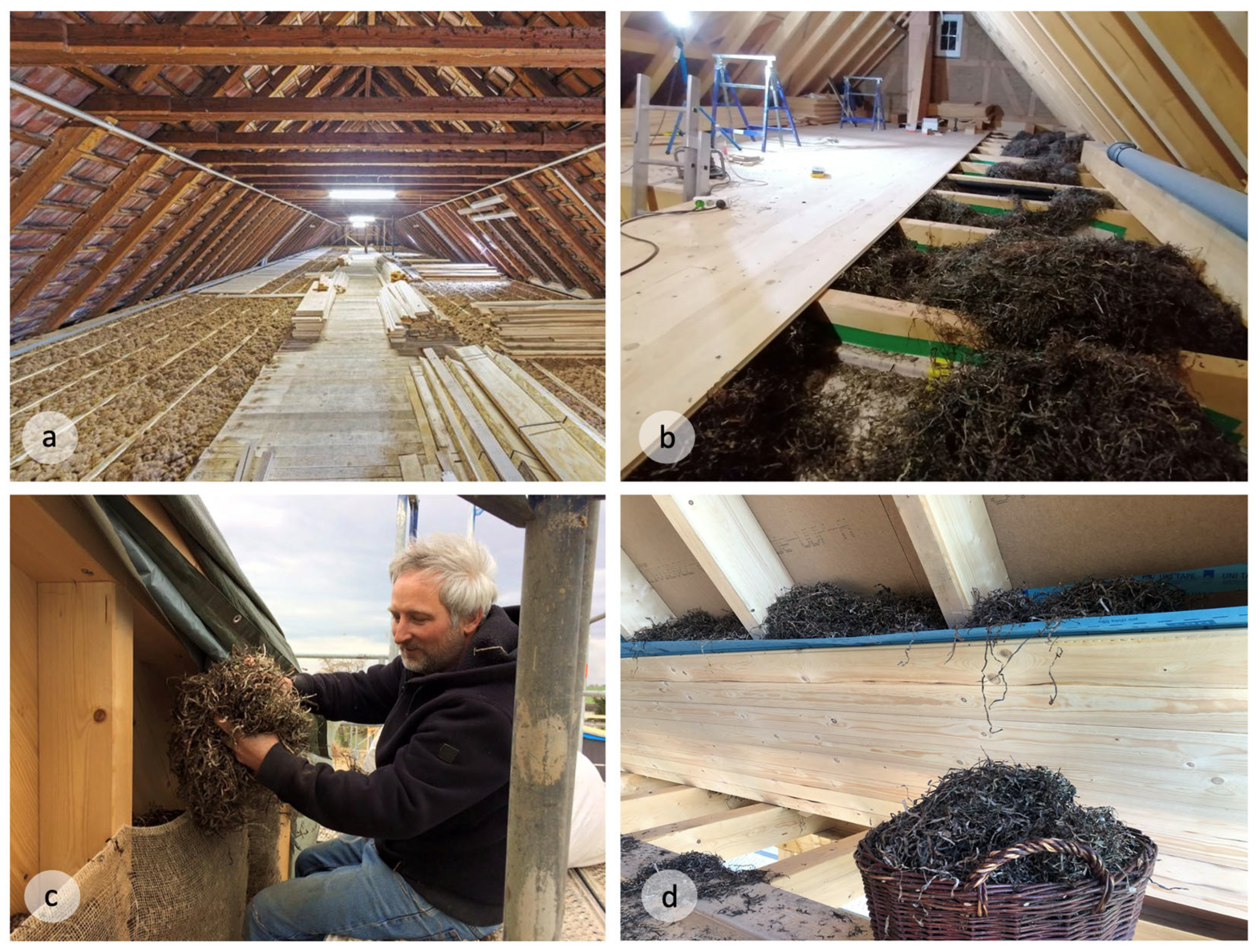
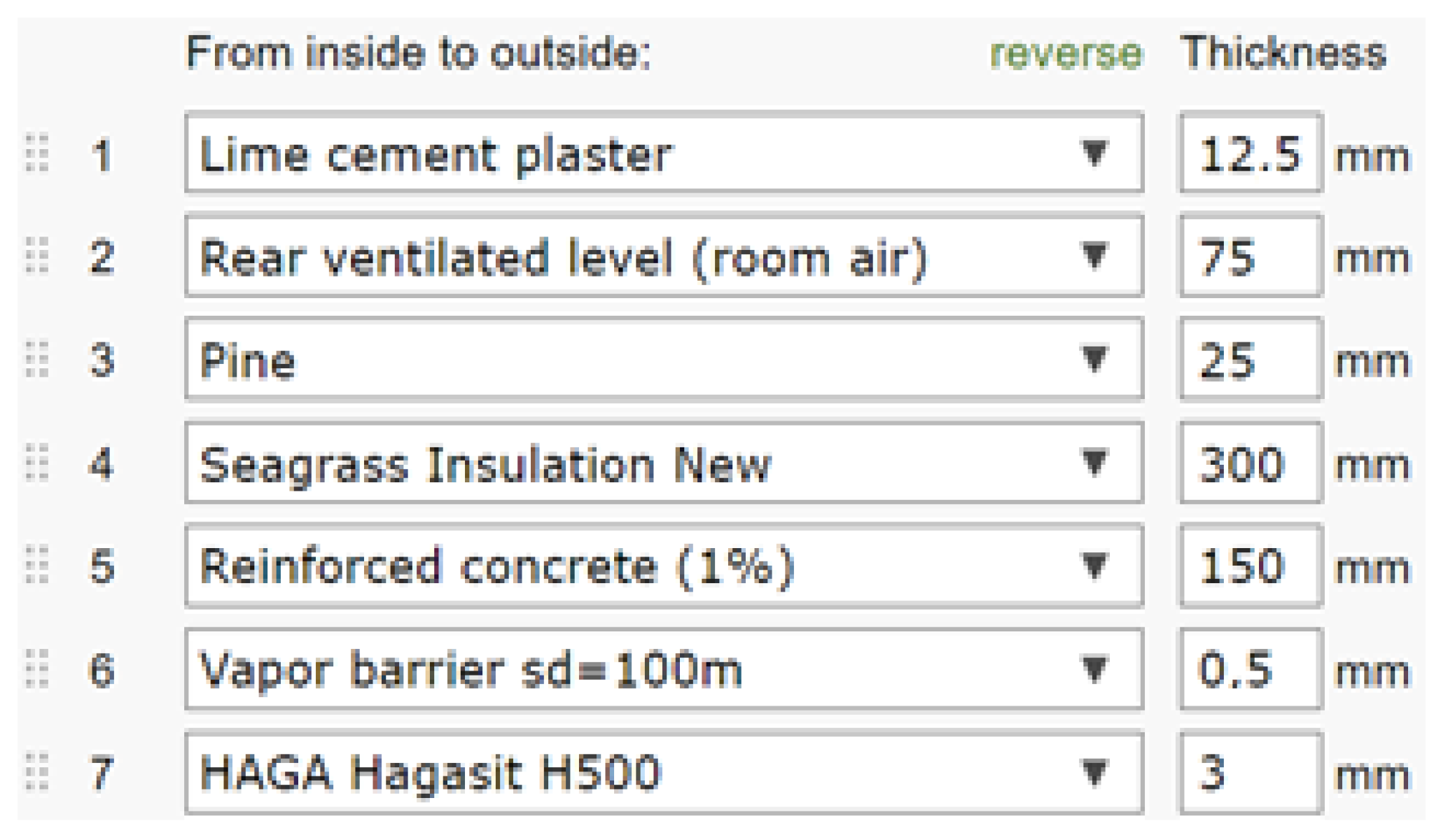
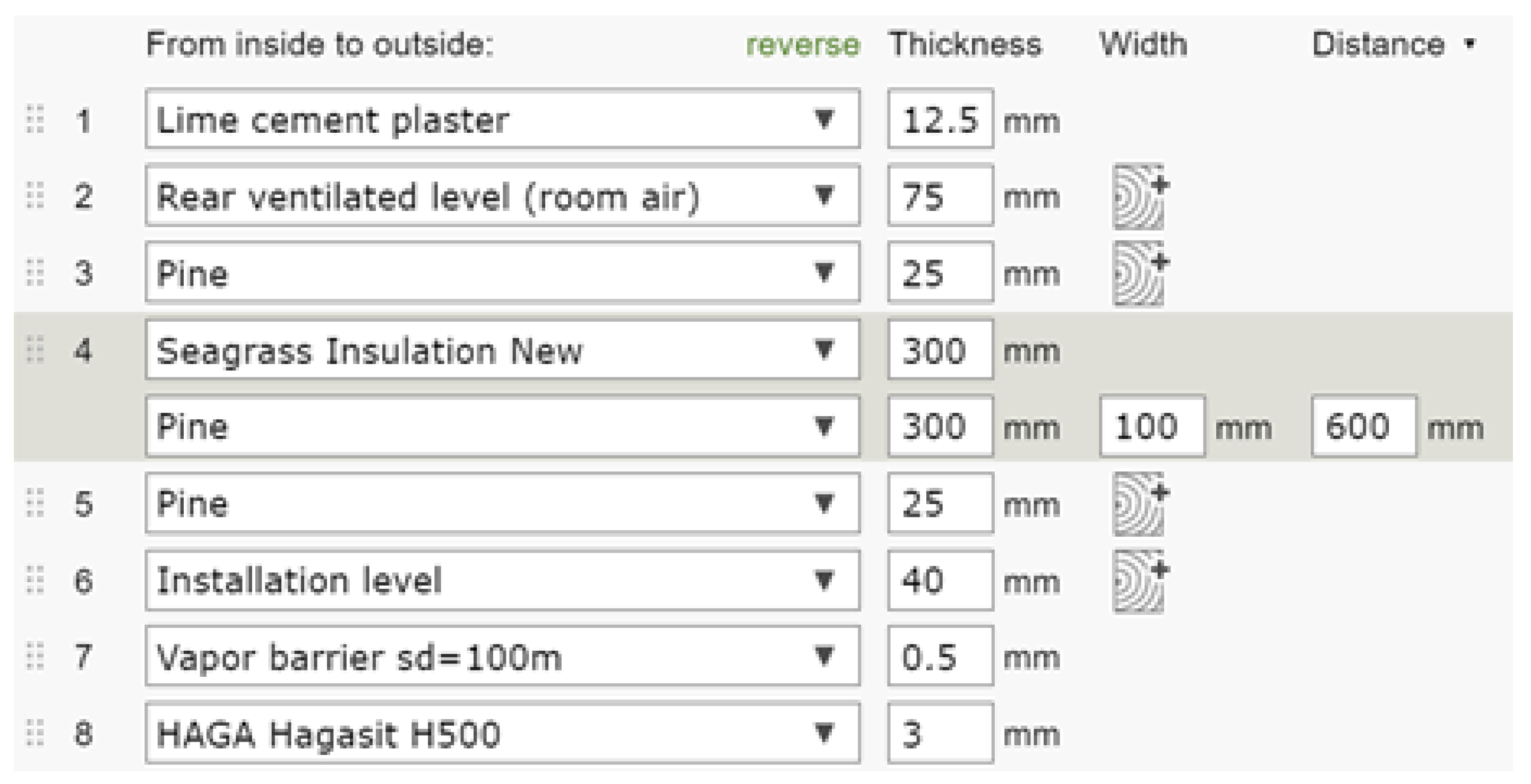
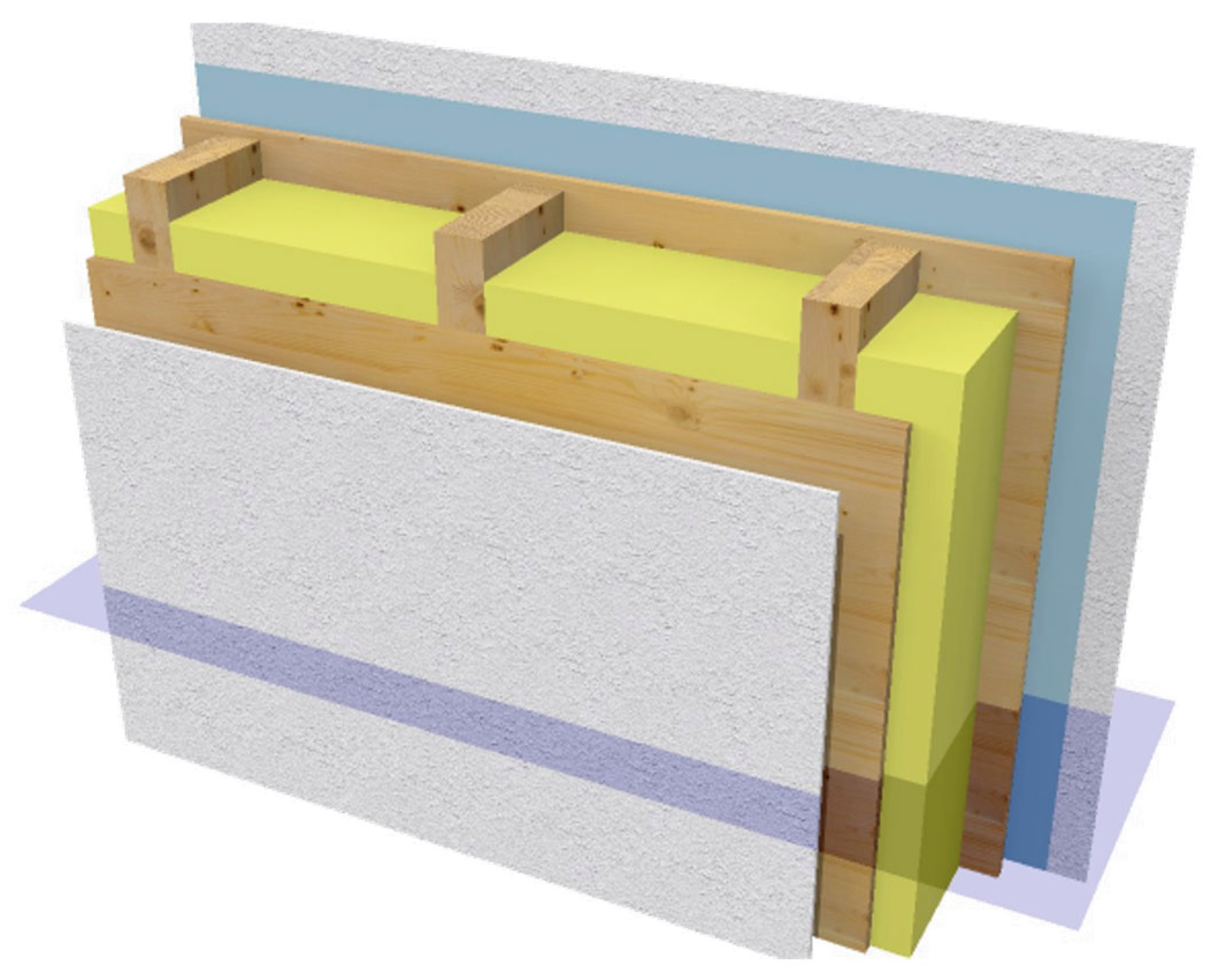
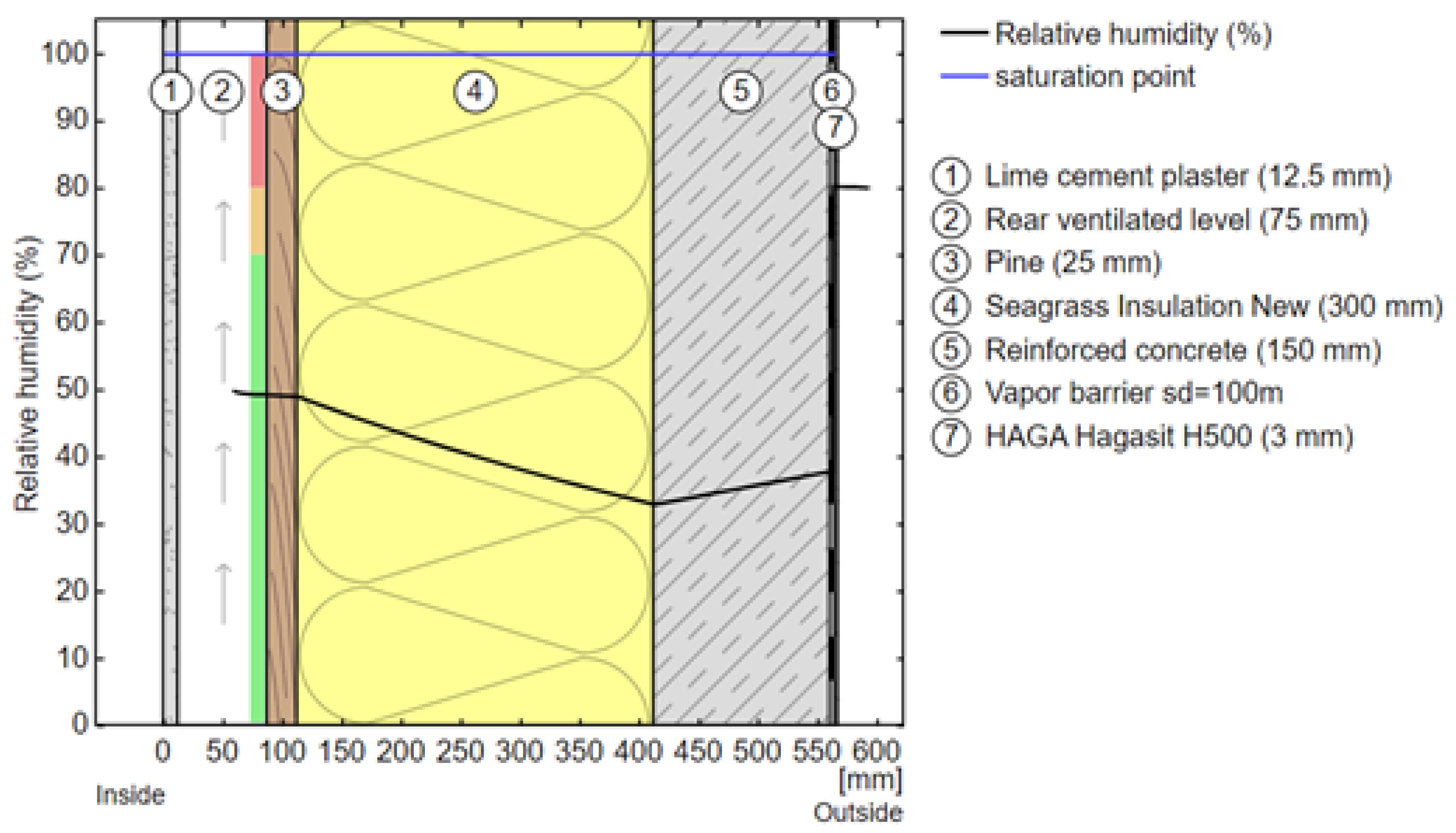

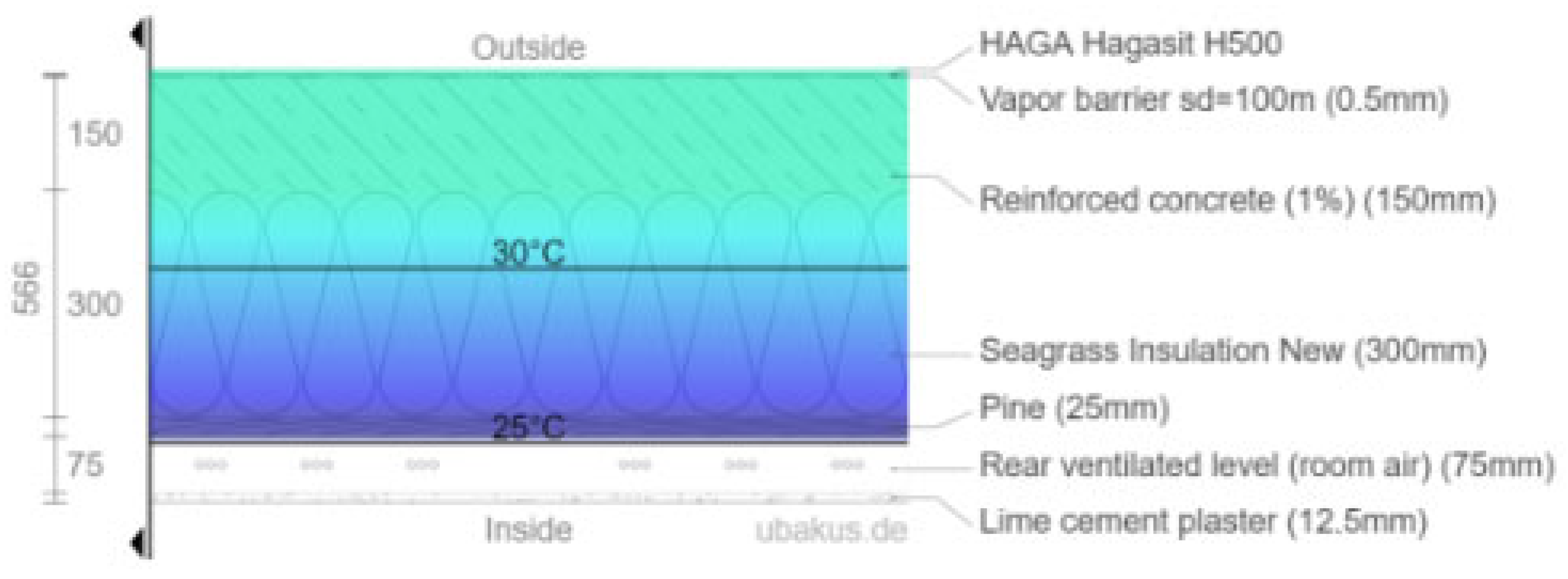
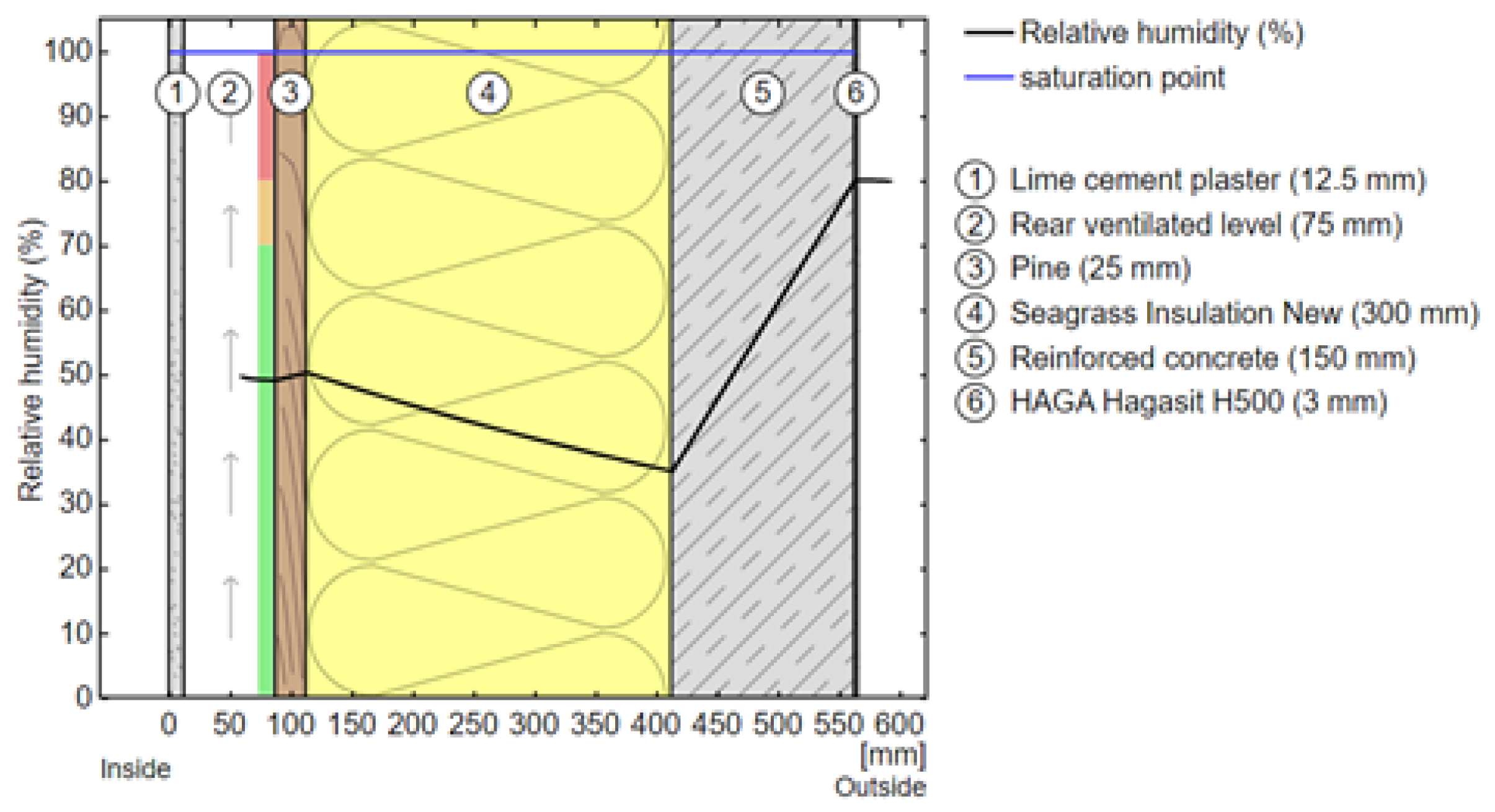
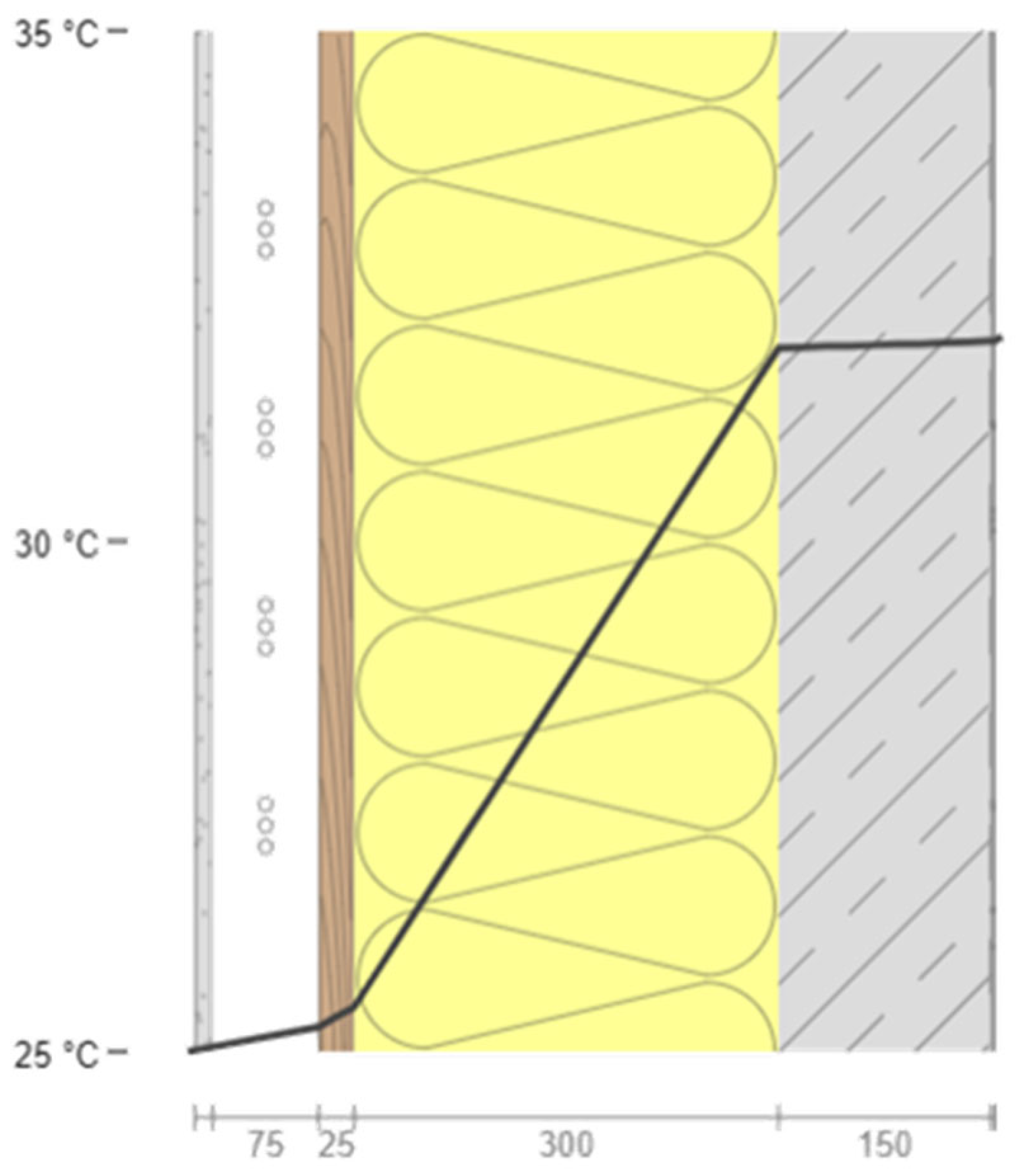

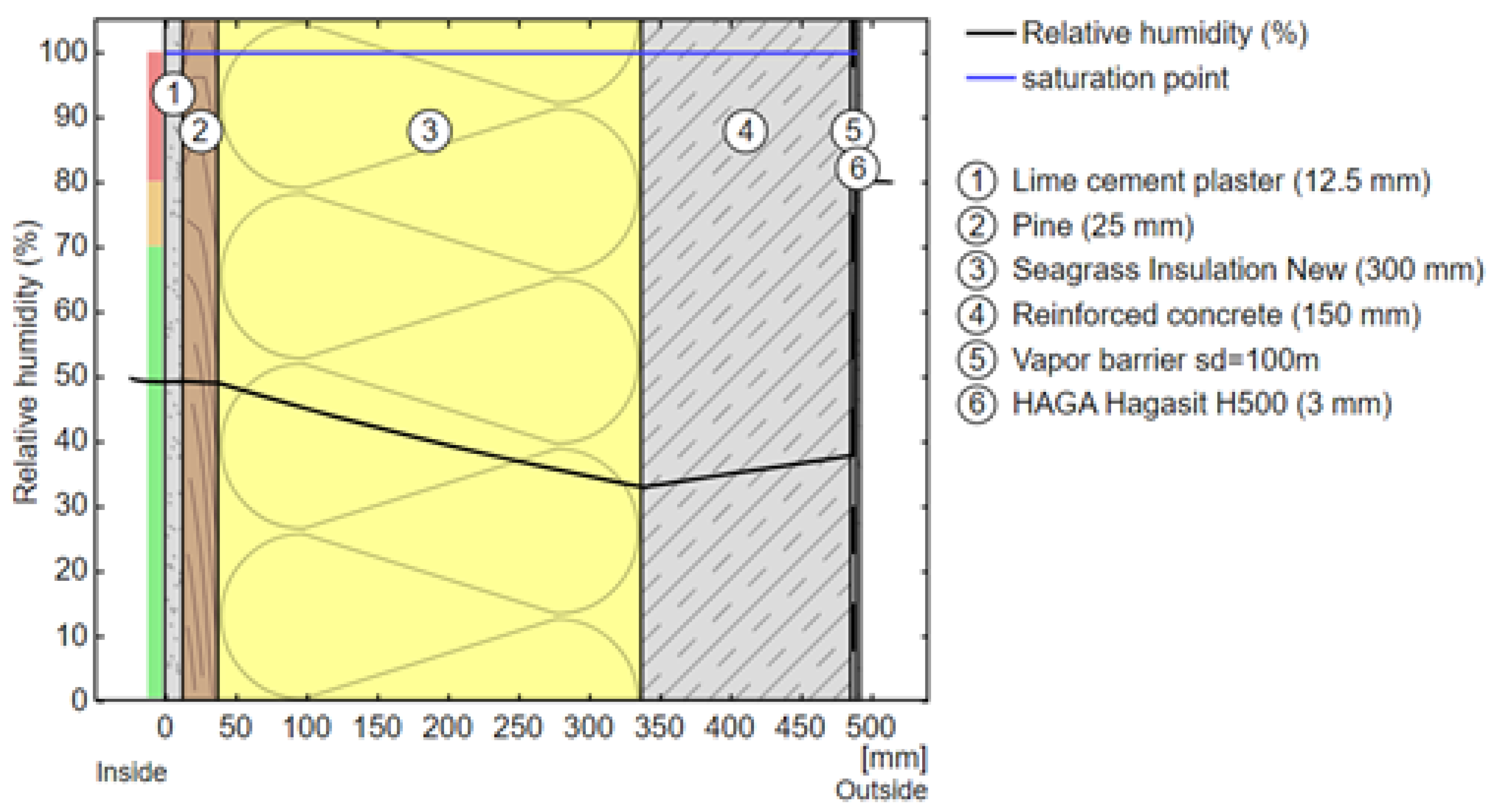
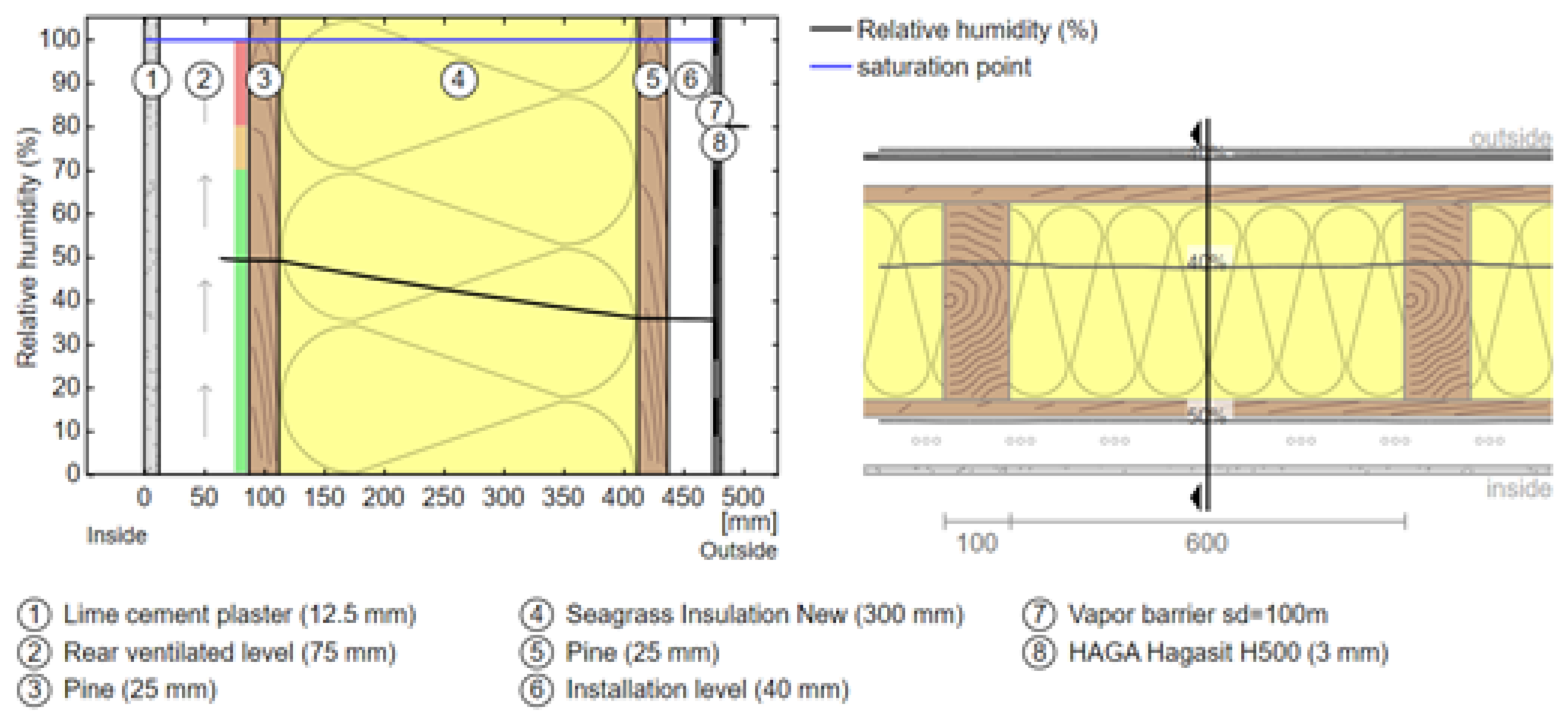
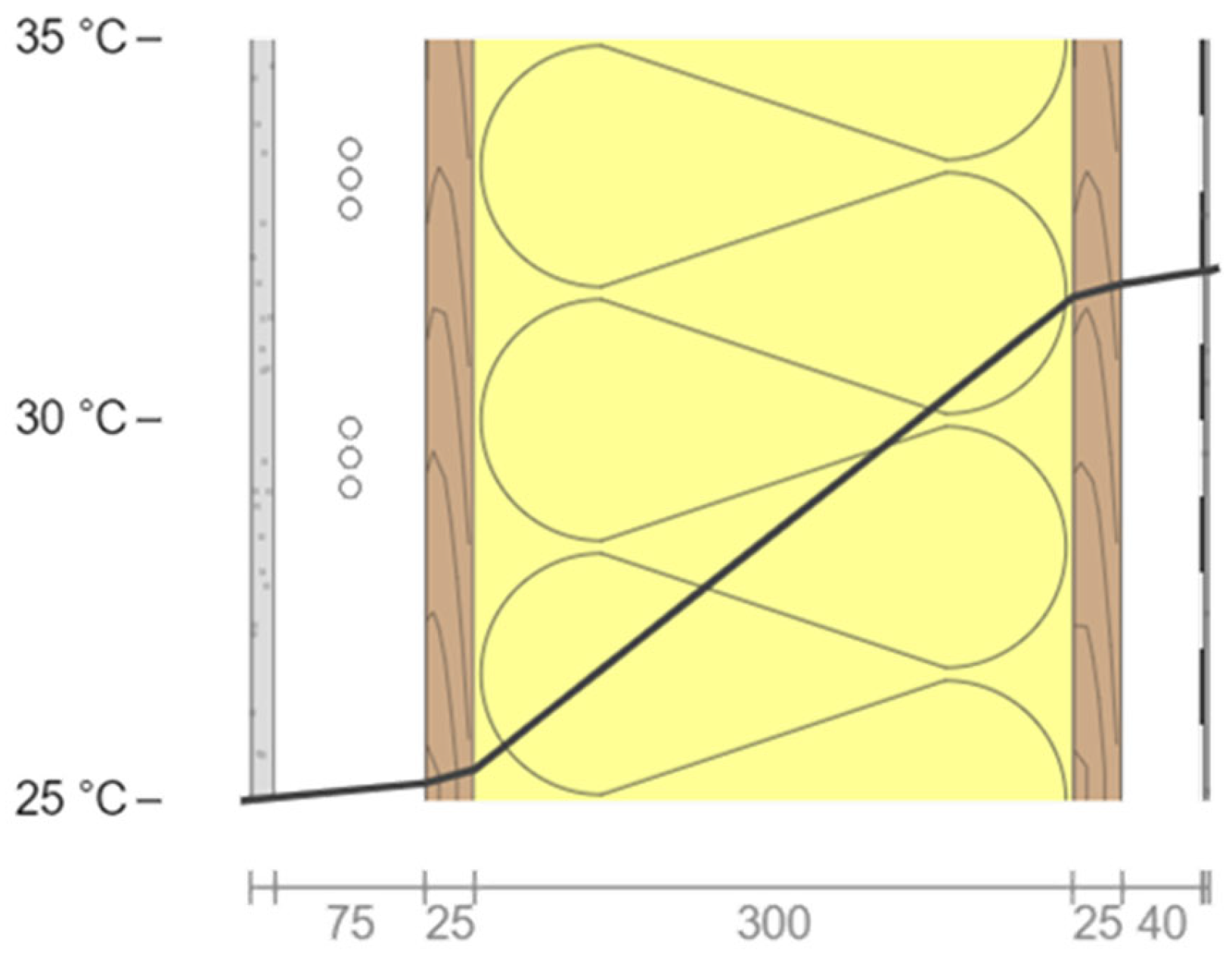
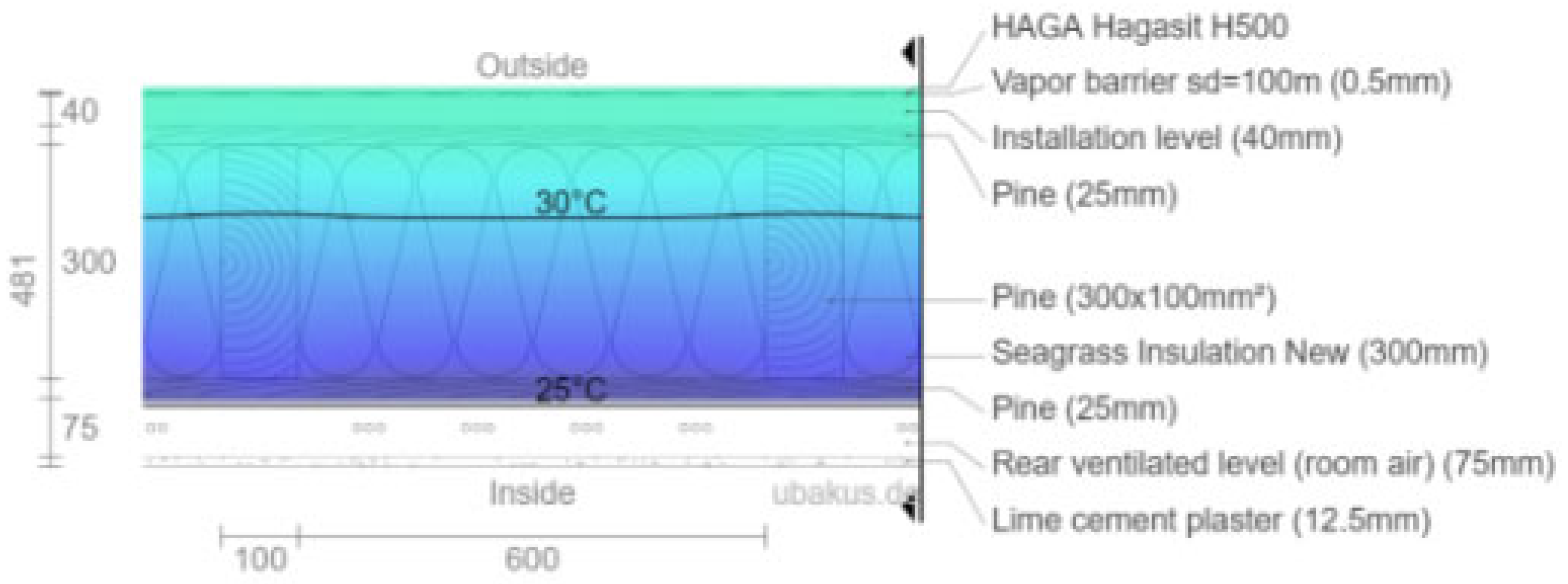
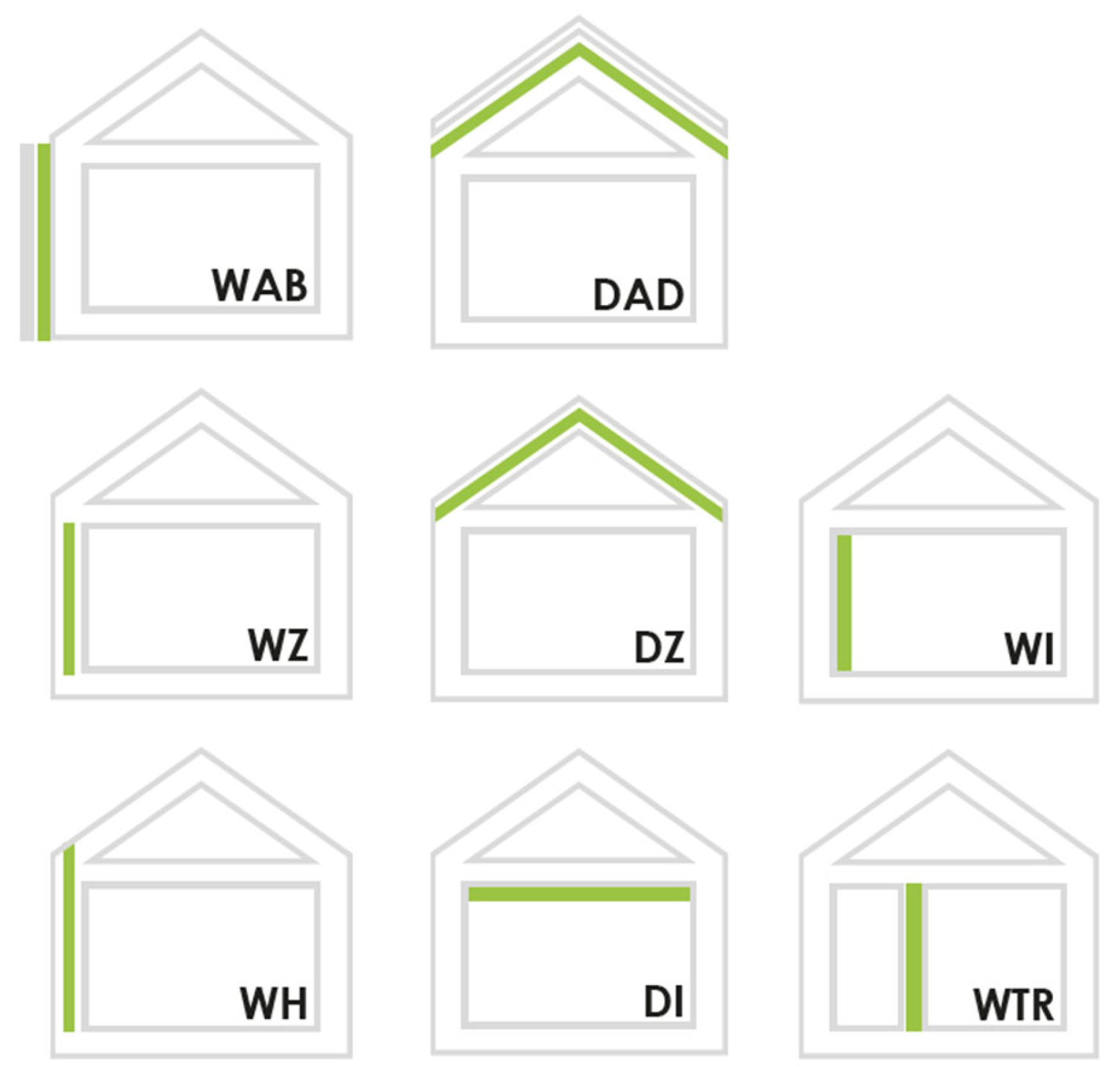
| Material | Bulk Density ρ [kg/m³] | Thermal Conductivity λ [W/(m·K)] | Specific Heat Capacity c [J/(kg·K)] | Fire Class | Vapour Diffusion Factor μ |
|---|---|---|---|---|---|
| Zostera marina (Seagrass) | 65–75 | 0.039–0.046 | 2500 | B2 (normal combustibility) | 1–2 |
| Cellulose | 25–90 | 0.040–0.045 | 1500 | B1, B2 | 1–2 |
| Flax | 20–40 | 0.040–0.050 | 1400 | B2 (normal combustibility) | 1–2 |
| Hemp | 20–40 | 0.040–0.080 | 1700 | B2 (normal combustibility) | 1–2 |
| Sheep’s wool | 20–80 | 0.040–0.045 | 1000 | B2 (normal combustibility) | 1–2 |
| Rock wool | 25–220 | 0.035–0.050 | 840 | A1, A2 (non-combustible) | 1–2 |
| Foam glass | 105–165 | 0.040–0.055 | 840 | A1, A2 (non-combustible) | ∞ |
| Expanded Polystyrene (EPS) | 15–40 | 0.032–0.038 | 1300 | E (sometimes D) | 20–100 |
| Glass wool (fiberglass) | 12–48 | 0.032–0.034 | 840 | A1 (non-combustible) | 1 |
| Rigid PU foam | 30–45 | 0.022–0.028 | 1400 | E/B3 | 30–100 |
| Sector | Expert Selection Criteria | Sources/ Method | Inclusion Criteria | Exclusion Criteria |
|---|---|---|---|---|
| Tourism | Large luxury hotels with air-conditioned rooms; likely to employ technical staff and afford alternative materials | Filtered search on https://www.agoda.com | 4–5 star hotels, presence of air-conditioned rooms, assumed access to engineering/technical staff | Small hotels, guesthouses, focus on sustainability (to avoid bias) |
| Seagrass Insulation | Manufacturers, suppliers, and project-experienced experts in seagrass insulation; one research institution | Based on literature review; direct contacts | Active involvement in seagrass insulation production, supply, or project supervision | Lack of direct connection to seagrass insulation |
| Biology | Frequently cited authors; members and directors of tropical research centres; biologists in the Seychelles | Derived from literature review and institutional affiliations | Frequent citation in literature, institutional role in tropical biology, geographic relevance (Seychelles) | Authors with marginal relevance or outside the tropical biology field |
| Construction | Construction companies active in building (excluding renovation-only firms) | Derived from literature review and institutional affiliations | Listed under “Construction” on SeyBusiness.com, involved in general construction projects | Companies focused solely on renovation work |
| Variant | Absolute Thermal Resistance Rt [m2·K/W] | U-Value [W/(m2·K)] | Heat Storage Capacity of Entire Building Component [kJ/(m2·K)] |
|---|---|---|---|
| Variant 1 | 7.102 | 0.141 | 378 |
| Variant 1.1 | 7.100 | 0.141 | 378 |
| Variant 1.2 | 7.115 | 0.141 | 400 |
| Variant 2 | 6.073 | 0.165 | 124 |
Disclaimer/Publisher’s Note: The statements, opinions and data contained in all publications are solely those of the individual author(s) and contributor(s) and not of MDPI and/or the editor(s). MDPI and/or the editor(s) disclaim responsibility for any injury to people or property resulting from any ideas, methods, instructions or products referred to in the content. |
© 2025 by the authors. Licensee MDPI, Basel, Switzerland. This article is an open access article distributed under the terms and conditions of the Creative Commons Attribution (CC BY) license (https://creativecommons.org/licenses/by/4.0/).
Share and Cite
Rothstein, B.; Heiderich, L.; Bühler, M.; Bhati, L.K. Seagrass as Climate-Smart Insulation for the Tropics: Key Insights from Numerical Simulations and Field Studies. Sustainability 2025, 17, 4160. https://doi.org/10.3390/su17094160
Rothstein B, Heiderich L, Bühler M, Bhati LK. Seagrass as Climate-Smart Insulation for the Tropics: Key Insights from Numerical Simulations and Field Studies. Sustainability. 2025; 17(9):4160. https://doi.org/10.3390/su17094160
Chicago/Turabian StyleRothstein, Benno, Lena Heiderich, Michael Bühler, and Lalit Kishor Bhati. 2025. "Seagrass as Climate-Smart Insulation for the Tropics: Key Insights from Numerical Simulations and Field Studies" Sustainability 17, no. 9: 4160. https://doi.org/10.3390/su17094160
APA StyleRothstein, B., Heiderich, L., Bühler, M., & Bhati, L. K. (2025). Seagrass as Climate-Smart Insulation for the Tropics: Key Insights from Numerical Simulations and Field Studies. Sustainability, 17(9), 4160. https://doi.org/10.3390/su17094160







